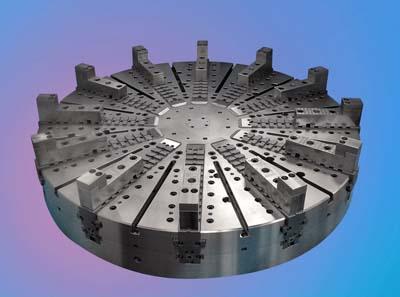
Newest diameter increases Royal Machine's Steel Bodied Manual VTL Large Diameter Chucks product range from 24 inches to 84 inches in diameter and are custom designed and built to customer requirements in the USA.
In making the announcement of the newest size 84 inch chuck, Guy Byrne, General Manager, stated, "We've had the ability to manufacture up to the 84 inch diameter Chucks since 2007, as far as milling, grinding and assembly were concerned. Where we had an issue was in the turning operation. Until recently, one of our key suppliers, Duel Manufacturing in Southington, Connecticut, which Royal has teamed up with for over the past 15 years, purchased another VTL with a 96 inch Diameter capacity. The newest VTL solved our issue. With the turning issue no longer holding our latest design back, it continues to evolve.
"Our design boasts its superior steel strength, induced wear resistant body, hardened and precision ground master jaws and wedge. This produces increased wedge style gripping forces and accuracies. Aside from these benefits, this 'Next Generation' design uses a readily replaceable pinion gear for added torque and also has improved chip protection to help reduce contamination and downtime for maintenance."
Contact Details
Related Glossary Terms
- chuck
chuck
Workholding device that affixes to a mill, lathe or drill-press spindle. It holds a tool or workpiece by one end, allowing it to be rotated. May also be fitted to the machine table to hold a workpiece. Two or more adjustable jaws actually hold the tool or part. May be actuated manually, pneumatically, hydraulically or electrically. See collet.
- gang cutting ( milling)
gang cutting ( milling)
Machining with several cutters mounted on a single arbor, generally for simultaneous cutting.
- grinding
grinding
Machining operation in which material is removed from the workpiece by a powered abrasive wheel, stone, belt, paste, sheet, compound, slurry, etc. Takes various forms: surface grinding (creates flat and/or squared surfaces); cylindrical grinding (for external cylindrical and tapered shapes, fillets, undercuts, etc.); centerless grinding; chamfering; thread and form grinding; tool and cutter grinding; offhand grinding; lapping and polishing (grinding with extremely fine grits to create ultrasmooth surfaces); honing; and disc grinding.
- milling
milling
Machining operation in which metal or other material is removed by applying power to a rotating cutter. In vertical milling, the cutting tool is mounted vertically on the spindle. In horizontal milling, the cutting tool is mounted horizontally, either directly on the spindle or on an arbor. Horizontal milling is further broken down into conventional milling, where the cutter rotates opposite the direction of feed, or “up” into the workpiece; and climb milling, where the cutter rotates in the direction of feed, or “down” into the workpiece. Milling operations include plane or surface milling, endmilling, facemilling, angle milling, form milling and profiling.
- turning
turning
Workpiece is held in a chuck, mounted on a face plate or secured between centers and rotated while a cutting tool, normally a single-point tool, is fed into it along its periphery or across its end or face. Takes the form of straight turning (cutting along the periphery of the workpiece); taper turning (creating a taper); step turning (turning different-size diameters on the same work); chamfering (beveling an edge or shoulder); facing (cutting on an end); turning threads (usually external but can be internal); roughing (high-volume metal removal); and finishing (final light cuts). Performed on lathes, turning centers, chucking machines, automatic screw machines and similar machines.
